Art Lovers discussion
Art History
>
Art Trivia of the Day (2011: January through March)
date newest »
newest »
 newest »
newest »
 Thank you. My daughter is very interested in art. I'm letting her see some of the artists recognized in this forum. I explained to her about Rosa Bonheur while showing her this.
Thank you. My daughter is very interested in art. I'm letting her see some of the artists recognized in this forum. I explained to her about Rosa Bonheur while showing her this.
 This is a great education, Aloha! I think it is wonderful that your daughter is into art. How old is she?
This is a great education, Aloha! I think it is wonderful that your daughter is into art. How old is she?
 She's 9. She has loved art since she was little. We have a little conflict now in that she's one of the top swimmers on her swim team, and she has to practice a minimum of 3 nights a week. That, along with custody with her dad, minimizes the time she can do anything else. She has asked me whether I can work art classes into her schedule. I am going to have to make a King Solomon's decision.
She's 9. She has loved art since she was little. We have a little conflict now in that she's one of the top swimmers on her swim team, and she has to practice a minimum of 3 nights a week. That, along with custody with her dad, minimizes the time she can do anything else. She has asked me whether I can work art classes into her schedule. I am going to have to make a King Solomon's decision.
 Aloha, do you have any art museums near you? Many offer programs on Saturday mornings or the last Saturday of the month. At the very least, you can bring in a sketchpad and drawing pencils.
Aloha, do you have any art museums near you? Many offer programs on Saturday mornings or the last Saturday of the month. At the very least, you can bring in a sketchpad and drawing pencils.Does she like to draw or paint or ?
 Carol, you constantly astonish me with the breadth of your interest in art and the beautiful postings you provide us.
Carol, you constantly astonish me with the breadth of your interest in art and the beautiful postings you provide us. I never heard of Rosa Bonheur. She would have been a contemporary of the Pre-Raphs who these days get most of the attention, no?
 Same time period, different country & different period in art.
Same time period, different country & different period in art.Bonheur was a Realist painter, which came later, after Romanticism (where I would place the Pre-Raphaelites).
Realism was the art movement (began in France in the 1850s) who positioned themselves against Romanticism, a genre that dominated French literature and artwork in early 19th century. Realists believed in the ideology of objective reality and revolted against the exaggerated emotionalism of the Romantic movement. Truth and accuracy became the goals of many Realists. Paintings depicted people at work (Industrial Revolution) .
 Realism like Courbet. Still never heard of her! I skipped the survey classes and now see something I missed.
Realism like Courbet. Still never heard of her! I skipped the survey classes and now see something I missed.
 Carol, I live in the northeast of the U.S., so the culture is incredible. There are no shortage of art classes here. The problem is time. It would have been no problem if her father would agree to help with taking her to classes, but he refused to take her to any extracurricular activities. He has refused to take her to any swim meets, so I take her on those weekends. It's useless having her take a weekend class, since she would be missing 50% because she'll be with her father every other weekend. So her weekdays are filled with swimming and having dinner with her dad. She's been on the team since she was 5, and it's part of her culture. It's going to be a tough decision if she is to fit art into her schedule.
Carol, I live in the northeast of the U.S., so the culture is incredible. There are no shortage of art classes here. The problem is time. It would have been no problem if her father would agree to help with taking her to classes, but he refused to take her to any extracurricular activities. He has refused to take her to any swim meets, so I take her on those weekends. It's useless having her take a weekend class, since she would be missing 50% because she'll be with her father every other weekend. So her weekdays are filled with swimming and having dinner with her dad. She's been on the team since she was 5, and it's part of her culture. It's going to be a tough decision if she is to fit art into her schedule.Carol wrote: "Aloha, do you have any art museums near you? Many offer programs on Saturday mornings or the last Saturday of the month. At the very least, you can bring in a sketchpad and drawing pencils.
Does s..."
 Carol,
Carol,I love your posts! Thanks especially for this one. I know how to post an image, but can not figure out how to do this one (my favorite Bonheur painting.) http://www.nga.gov/exhibitions/2008/f... Forest of Fontainebleau: Spring in the woods.
I would give anything to travel back in time and see that exhibition.
 Honestly, if I didn't know, I would think it was a photo.
Honestly, if I didn't know, I would think it was a photo.Aloha, regarding your daughter-- when I was very, very young my grandmother would give me her note pad (from her purse) to draw on while we were at church. Later I always kept a pad and pencil with me wherever I went (it was small enough to keep in my bag.) I drew all the time, no matter where I was. One of the first gifts I got was pastels which I loved.
 Happy birthday to French sculptor Francois Girardon born on March 17, 1628 in Troyes.
Happy birthday to French sculptor Francois Girardon born on March 17, 1628 in Troyes.[image error]
Statue of Louis XIV on Horse, Louvre, 1692
He studied in Troyes and in Rome, and in 1657 he became a member of the French Royal Academy. In 1666 he received his most famous commission, the Apollo Tended by the Nymphs, for the Grotto of Thetis at Versailles. Of his other works at Versailles, the most notable are The Bath of the Nymphs (1668 – 70) and The Rape of Persephone (1677 – 79). Although superficially a Baroque artist, Girardon's deep-seated Classical tendencies also emerge in the serene solemnity of his two principal works outside Versailles: an equestrian statue of Louis XIV (1683 – 92), destroyed in the French Revolution, and the tomb of Cardinal Richelieu in the church of the Sorbonne (1675 – 94). Though influenced by the work of Gian Lorenzo Bernini, his own style was more restrained. He died in Paris on Sept. 1, 1715. (answers.com)
[image error]
Apollo Tended by the Nymphs
[image error]
[image error]
The Rape of Persephone
 Happy birthday to Russian artists Mikhail Aleksandrovich Vrubel born on March 17, 1856 in Omsk, Russia.
Happy birthday to Russian artists Mikhail Aleksandrovich Vrubel born on March 17, 1856 in Omsk, Russia.[image error]
Self portrait 1885
He was regarded amongst the greatest Russian painters of the Symbolist movement. He was a pioneer of modernism, and his highly innovative technique broke with the traditions of the Academy of Arts in St Petersburg, where he had been a brilliant student; at the same time he felt dissociated from the social consciousness of The Wanderers. He remained a lonely figure in Russian art, but he was the only one of his generation who successfully achieved the monumentality for which so many painters were aiming. (wikipedia)
[image error]
It is the large painting of Seated Demon (1890) that brought notoriety to Vrubel. Most conservative critics accused him of "wild ugliness", whereas the art patron Savva Mamontov praised the Demon series as "fascinating symphonies of a genius" and commissioned Vrubel to paint decorations for his private opera and mansions of his friends. Unfortunately the Demon, like other Vrubel's works, doesn't look as it did when it was painted, as the artist added bronze powder to his oils in order to achieve particularly luminous, glistening effects.
[image error]
Portrait of Nadezhda Zabela-Vrubel – The Artist's Wife (1898)
In 1896, he fell in love with the famous opera singer Nadezhda Zabela. Half a year later they married and settled in Moscow, where Zabela was invited by Mamontov to perform in his private opera theatre. While in Moscow, Vrubel designed stage sets and costumes for his wife, who sang the parts of the Snow Maiden, the Swan Princess, and Princess Volkhova in Rimsky-Korsakov's operas. Falling under the spell of Russian fairy tales, he executed some of his most acclaimed pieces, including Pan (1899), The Swan Princess (1900), and Lilacs (1900).
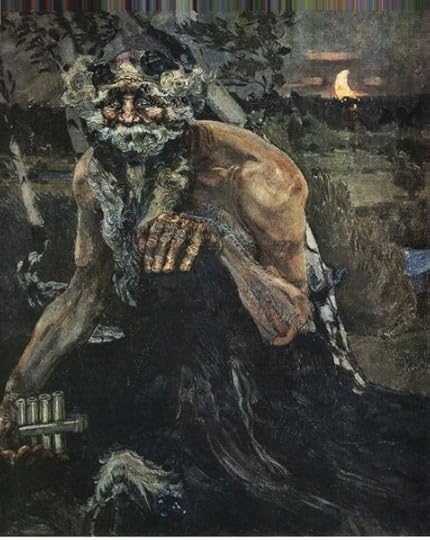
Pan, 1899
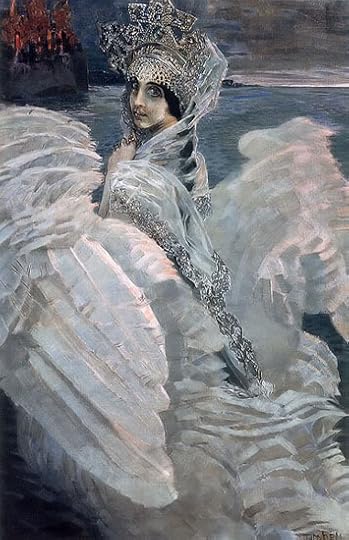
The Swan Princess (1900)
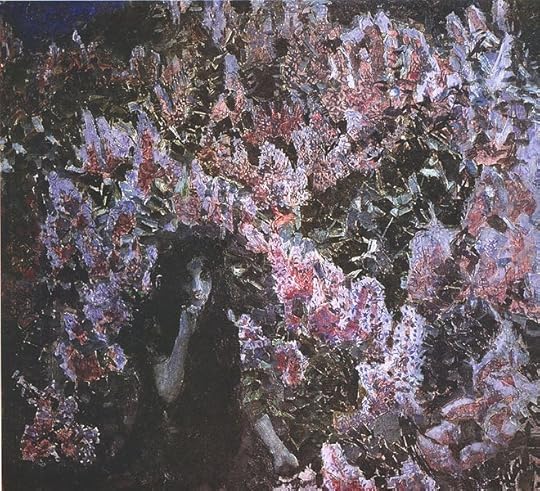
Lilacs, 1900
In 1901, Vrubel returned to the demonic themes in the large canvas Demon Downcast. In order to astound the public with underlying spiritual message, he repeatedly repainted the demon's ominous face, even after the painting had been exhibited to the overwhelmed audience. At the end he had a severe nervous breakdown and was hospitalized in a mental clinic. Vrubel's mental illness was brought on or complicated by tertiary syphilis. While there, he painted a mystical Pearl Oyster (1904) and striking variations on the themes of Pushkin's poem The Prophet. In 1906, overpowered by mental disease and approaching blindness, he gave up painting. He died in St, Petersburg on April 19, 1910.
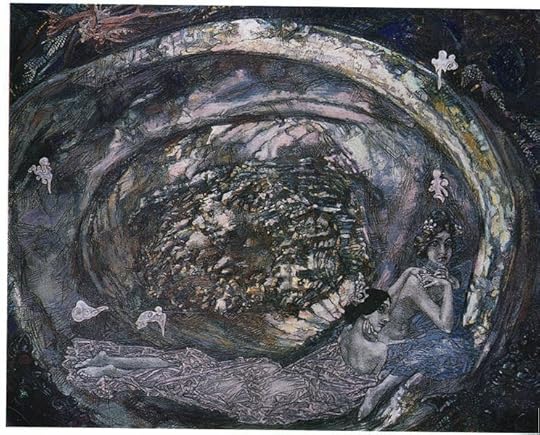
Pearl Oyster, 1904
 Happy birthday to Jozef Mazur born on March 17, 1897 in Poland.
Happy birthday to Jozef Mazur born on March 17, 1897 in Poland. 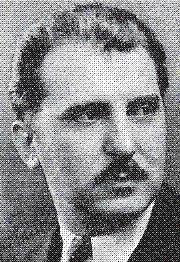
He was was an Polish-American (Galician) stained glass artist, painter and sculptor. (His works can be found signed as Josef Mazur, Joseph Mazur, Joe Mazur, J. C. Mazur as well as a few others.)
In Masten Park High School Jozef excelled in his study of art, so much so that after his graduation he received an apprenticeship at a stained glass studio. After serving in World War I, he earned a scholarship for Buffalo (Albright) Arts School and then attended the Art Students League of New York. Upon his return to Buffalo in 1925, Mazur received one of the most important commissions of his career: the redecoration of St. Stanislaus Bishop and Martyr Church, the Mother Church of Polonia. Over the next twenty years he decorated such churches as, St. Adalbert's Basilica, Holy Mother of the Rosary Cathedral, and Transfiguration Church. His most famous secular work from this time would be the bust of Chopin in front of Kleinhans Music Hall.
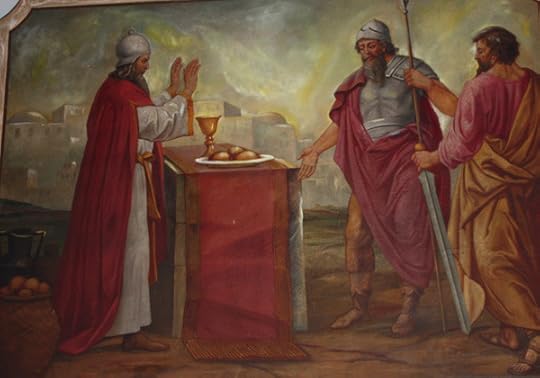
The Meeting of Abraham and Melchizedek
Starting in the early 1950's Mazur created stained glass windows for St. Rita and St. Margaret in Buffalo and Our Lady of Czestochowa in North Tonawanda. In 1955, he decorated the University at Buffalo's Polish Room. Jozef and his wife, Stefa, donated a stained glass lamp depicting Chopin, Mickiewicz, Paderewski, and Slowacki to the University. They also included four stained glass medallions portraying Marie Curie Sklodowska, Nicolaus Copernicus, and two other famous Poles.
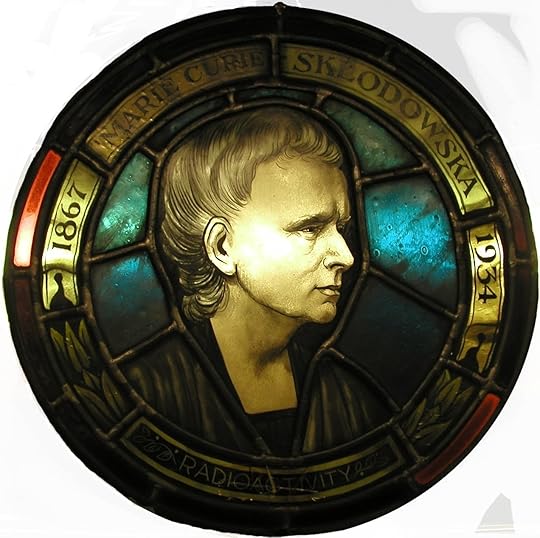
Stained glass medallion of Marie Curie
Marie Curie Medallion Returns to UB Polish Collection By Way of eBay -- http://www.buffalo.edu/news/8829
By the time, Mazur completed his last stained glass commission in 1960 for SS. Peter & Paul in Hamburg his health was in decline. Windows in Saints Peter and Paul RC Church, Hamburg, NY:
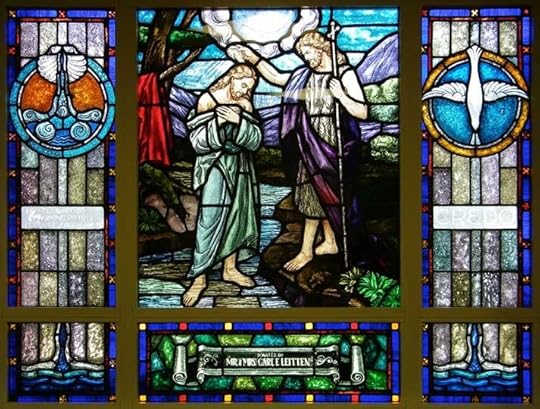
Baptism of Jesus
[image error]
The Resurrection
[image error]
The Ascension
After a long illness, Jozef Mazur passed away on April 23, 1970.
 I've always drawn and painted with her since she was a babe, when she could only scribble. When her father and I were together, she was able to take art classes along with being on the swim team. Her skills blossomed with art classes. But now, with time divided due to custody issues and increased swim practice time, I have to talk with her as to what is the most important.
I've always drawn and painted with her since she was a babe, when she could only scribble. When her father and I were together, she was able to take art classes along with being on the swim team. Her skills blossomed with art classes. But now, with time divided due to custody issues and increased swim practice time, I have to talk with her as to what is the most important.Carol wrote: "Honestly, if I didn't know, I would think it was a photo.
Aloha, regarding your daughter-- when I was very, very young my grandmother would give me her note pad (from her purse) to draw on while w..."
 Carol, my daughter Gabrielle was an art major in the University of Fine Art in Florence Italy. She is a new member on Goodreads and also an avid reader. She will love this group I'm sure. Thank you so much for the wonderful insights you bring to light...Johnny Flora
Carol, my daughter Gabrielle was an art major in the University of Fine Art in Florence Italy. She is a new member on Goodreads and also an avid reader. She will love this group I'm sure. Thank you so much for the wonderful insights you bring to light...Johnny Flora
 Johnny wrote: "Carol, my daughter Gabrielle was an art major in the University of Fine Art in Florence Italy ..."
Johnny wrote: "Carol, my daughter Gabrielle was an art major in the University of Fine Art in Florence Italy ..."Thanks Johnny. I just love art & like to post. Heather is the one who deserves all the credit for everything on this site.
I look forward to talking with Gabrielle.
 That painting of the woods in Fountainbleau had the same impression on me. It looks so real I scrolled to see if there was a painting below! I'd go back to the exhibition, too, Divvy. Is there a web link or book you'd recommend?
That painting of the woods in Fountainbleau had the same impression on me. It looks so real I scrolled to see if there was a painting below! I'd go back to the exhibition, too, Divvy. Is there a web link or book you'd recommend?I didn't care much for the main building of Versailles, but the gardens must be wonderful. I wish I'd only spent time in the gardens. Apollo Tended by the Nymphs, for the Grotto of Thetis would be one reason to return. It reminds me of the elongated figures by Primaticcio with the refinement of Bandinelli and Ammanati. In other words, very Italian and very, very good! The Rape of Persephone is derivative but worthy.
I'm curious. Was Mazur's mother Spanish? Why is he considered Galatian?
 I was bored and created a the Visual Arts Trivia quiz. Hope you like it:
I was bored and created a the Visual Arts Trivia quiz. Hope you like it: http://www.goodreads.com/quizzes/recent
 I didn't answer any questions being unsure of the answers. I've read several books about Cornell and none touched on any romantic relationships. He cared for his mother and younger brother with cerebral palsy. If there were relationships I find it odd he'd have been involved with Susan Sontag! Where did you discover this? She was lesbian (a decade with Annie Liebowitz)/later bi-sexual and of all the relationships mentioned none mentioned Cornell.
I didn't answer any questions being unsure of the answers. I've read several books about Cornell and none touched on any romantic relationships. He cared for his mother and younger brother with cerebral palsy. If there were relationships I find it odd he'd have been involved with Susan Sontag! Where did you discover this? She was lesbian (a decade with Annie Liebowitz)/later bi-sexual and of all the relationships mentioned none mentioned Cornell.
 That one I read on Utopia Parkway by Deborah Solomon. It was so bizarre that it stuck in my mind. It was not a romantic affair though. It was more of a weird brief fling. I googled it and used the phrasing from the website of Museum of Fine Arts in Boston: http://www.mfa.org/collections/public...
That one I read on Utopia Parkway by Deborah Solomon. It was so bizarre that it stuck in my mind. It was not a romantic affair though. It was more of a weird brief fling. I googled it and used the phrasing from the website of Museum of Fine Arts in Boston: http://www.mfa.org/collections/public...
 How strange! Truth is stranger than fiction! I have Utopia Parkway but now I'm not sure I want to read it. Did you read Stargazing in the Cinema? Now that was one beautiful book!
How strange! Truth is stranger than fiction! I have Utopia Parkway but now I'm not sure I want to read it. Did you read Stargazing in the Cinema? Now that was one beautiful book!
 Just for the heck of it, here's a painting terminology quiz:
Just for the heck of it, here's a painting terminology quiz:Italian Painting Terms
(is this the right forum for this?... there's so many!)
 @Mon,
@Mon,Q: What is the Italian term, literally meaning shaded off, for colours that have been blended softly into each other, rather than having sharp outlines ?
Can't remember which one I guessed, but it was incorrect.
 sfumato - it literally means smoky. Leonardo used it. It's often said that it contributes to the Mona Lisa's mystery.
sfumato - it literally means smoky. Leonardo used it. It's often said that it contributes to the Mona Lisa's mystery.
 I got 7 out of 8...what a fun quiz. I was surprised that I remembered so many! I am not an artist, so the terms are truly words on a page and visual comprehension of art on paper. I'll bet they mean more when you can actually create the effects.
I got 7 out of 8...what a fun quiz. I was surprised that I remembered so many! I am not an artist, so the terms are truly words on a page and visual comprehension of art on paper. I'll bet they mean more when you can actually create the effects.
 Well, I guess I'm the failure here, I only got 6 out of 8. :( But I had fun! That's the point right?
Well, I guess I'm the failure here, I only got 6 out of 8. :( But I had fun! That's the point right?
 Alla prima is the one I got wrong. All the choices were very clever and since I had no idea I think I chose alla uno!
Alla prima is the one I got wrong. All the choices were very clever and since I had no idea I think I chose alla uno!
 There's a follower of Leonardo named Bernardino Luini whose work is ALL about sfumato! He did HUNDREDS of paintings all over a church in Milan and I fell in love with his work. Here's a link about the Borromeo collection. http://www.liechtensteinmuseum.at/en/... Carlo was so well loved, his body is encased in glass. http://en.wikipedia.org/wiki/Charles_...
There's a follower of Leonardo named Bernardino Luini whose work is ALL about sfumato! He did HUNDREDS of paintings all over a church in Milan and I fell in love with his work. Here's a link about the Borromeo collection. http://www.liechtensteinmuseum.at/en/... Carlo was so well loved, his body is encased in glass. http://en.wikipedia.org/wiki/Charles_...

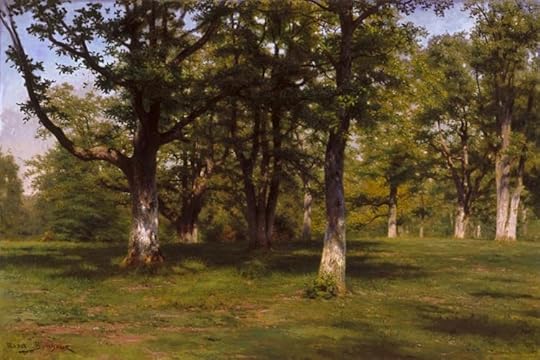




Bonheur is widely considered to have been the most famous female painter of the nineteenth century.
She was trained by her father, an art teacher, and began exhibiting regularly at the Paris Salon in 1841. Her unsentimental paintings of lions, tigers, horses, and other animals became very popular; The Horse Fair (1853) gained her an international reputation. A colorful personality, she dressed as a man to study horses at the actual Horse Fair in Paris, receiving formal permission from the police to do so. In 1865 she became the first woman to receive the Grand Cross of the Legion of Honour. She died on May 25, 1899 in Melun. (answers.com)
The Horse Fair, 1853–55, Oil on canvas, 96 1/4 x 199 1/2 in., The Metropolitan Museum of Art
When Rosa Bonheur exhibited The Horse Fair at the Salon of 1853, her reputation as an artist had been fairly well established by the paintings, drawings, and sculpture she had shown at the annual Salons since 1841, but few of her works attained the dash and grandeur of The Horse Fair, and none received the same acclaim. Vastly admired on the Continent, where it was exhibited in Paris, Ghent, and Bordeaux, the painting was subsequently shown in England and the United States. It has become one of the Metropolitan Museum's best known works of art.
Ploughingin the Nivemais
MORE: http://www.artinthepicture.com/artist...